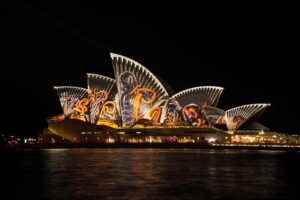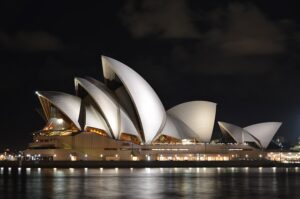Australia’s theatre entertainment is known for its minimal use of props and costumes in stage presentations, to ensure a closer performer-audience interconnection.
Generally, the theatrical concepts have a universal appeal since ideas and styles are not exclusive to Australian society. Yet watching artistic performances in the country’s famous Sydney Opera House (SOH) is a different experience altogether. A multi-venue performing arts facility, the SOH’s impressive architectural and engineering designs earned the Australian landmark recognition as one of the world’s finest 20th century masterpieces.
About Australia’s Sydney Opera House
Since its official opening in 1973, the Sydney Opera House has been the venue of choice for many of the world’s famous artists and performers. Numerous local and international personalities have also convened at the SOH to discuss matters of significant importance.
The construction of the facility was actually conceptualised in 1954, when then New South Wales Premier Joseph Cahill, envisioned the building of an edifice that would “help mould a more enlightened and better Australian community.” Today, it stands at the forefront of Sydney Harbour, posing as the country’s most globally recognizable landmark.
 Yet it was a highly controversial project as many opposed the substantial costs it was taking to complete the grandiose architectural design that required excellent engineering skills and know-how.
Yet it was a highly controversial project as many opposed the substantial costs it was taking to complete the grandiose architectural design that required excellent engineering skills and know-how.
The SOH was actually built and completed in three phases of construction:
- Building of the upper podium from 1959 to 1963;
- Construction from 1963 to 1967 of the outer shells, which were actually sections of spherical structures forming the roofs of the monumental podium.
- The final phase which transpired in 1967 up to 1973, saw the completion of the interior design and finishing touches of the entire world class facility.
It’s worth mentioning that the Sydney Opera House was designed by Danish Architect Jorn Utzon, as winner of the international competition held by the Australian government for this specific purpose.
Significant Features that Earned the SOH International Fame and Recognition
The Sydney Opera House is described as a modern expressionist design, highlighted by the shell-like structures forming the roofs of the colossal podium. They are actually large precast concrete sections of a sphere weighing up to 15 tonnes each. To effectively give the roof structures their shell-like appearance, a combination of about 1,056,006 glossy and matte, chevron-patterned tiles in white and cream, were used to cover the precast concrete sphere sections. The tiles were imported from Hoganas AB, a Swedish company that specialises in stoneware.
Since Australian soil is known for being largely unstable,the underpinning of the SOH foundation made use of 588 concrete piers that were embedded and drilled deep underneath the building’s foundation, sunk deep up to 25 metres or 82 feet below sea level.
Concrete pier installation, by the way, is a foundation underpinning technique used in construction to effectively strengthen or repair the foundations of a home or building. As additional information, there are other methods of foundation underpinning perth ground improvement specialists offer, to address foundation stabilisation issues. Popular examples include chemical grout injection or installations of injected grout blocks.


 Generally, the theatrical concepts have a universal appeal since ideas and styles are not exclusive to Australian society. Yet watching artistic performances in the country’s famous Sydney Opera House (SOH) is a different experience altogether. A multi-venue performing arts facility, the SOH’s impressive architectural and engineering designs earned the Australian landmark recognition as one of the world’s finest 20th century masterpieces.
Generally, the theatrical concepts have a universal appeal since ideas and styles are not exclusive to Australian society. Yet watching artistic performances in the country’s famous Sydney Opera House (SOH) is a different experience altogether. A multi-venue performing arts facility, the SOH’s impressive architectural and engineering designs earned the Australian landmark recognition as one of the world’s finest 20th century masterpieces.